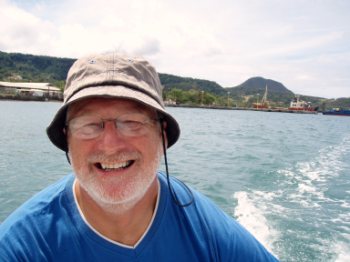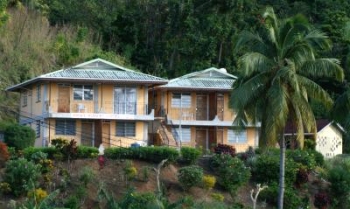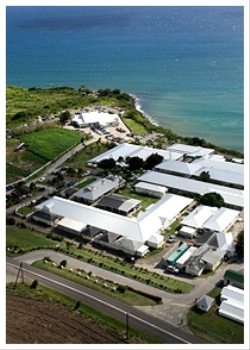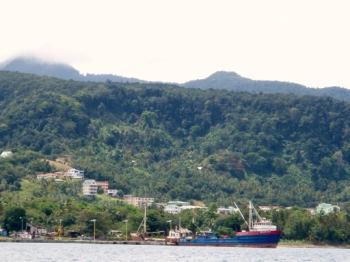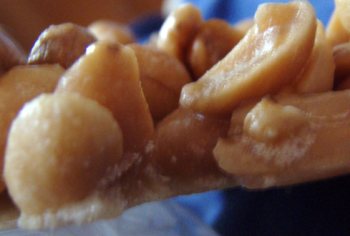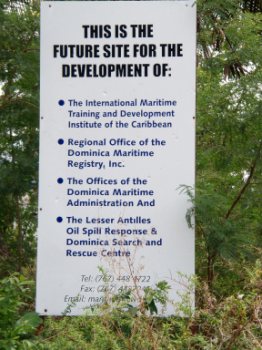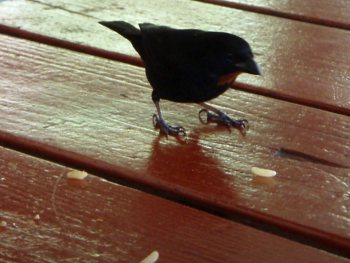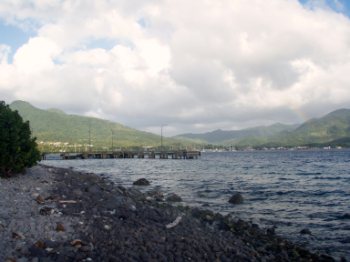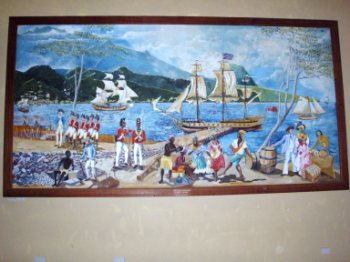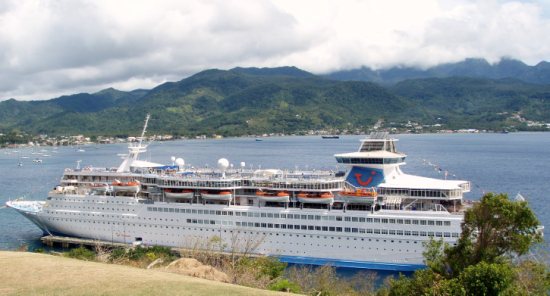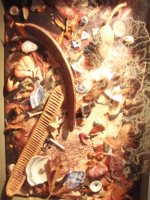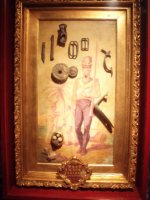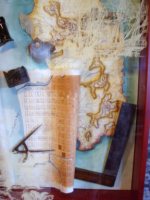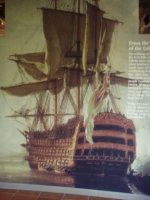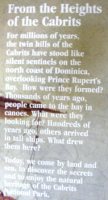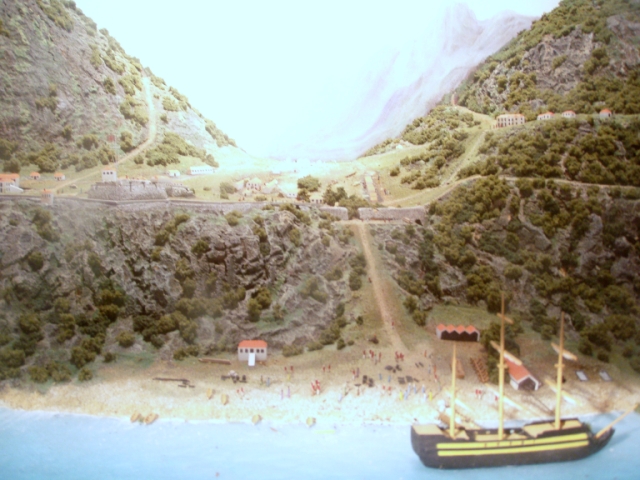Cabrits National Park

|
Exploring and Cabrits National Park
This could be an interesting blog, we have each ‘done a bit’.
We decided to get up and go for a day of exploring, first giving the outboard motor a throat clearing by roaring across the water to get some pictures of this side of the bay. Cheesy skipper having had a very competent one armed engineer service the outboard. Sad to see the relic of a tug boat on the shore. Being laid back Caribbean a boat called Abiding Love.
Prince Rupert Suites are part of the quite expensive student lodgings of the Ross University Medical School, home to about a thousand US medical students plus others from the surrounding Caribbean islands. The view we have of the medical school complex.
A little cutey called Sister. A visiting Canadian boat called Caledonia and always some activity going on. We then dropped in to the town for a few vitals and to see if we could clear out the following day at the Police Station, to be told by a woman you would not argue with “come back the day you want to go”.
First time in my life I have bought eggs in a bag. Should not have discovered home made nut brittle at one of the bread stalls, here more nut than brittle.
Having dropped shopping and boat papers back to Beez it was off to Cabrits. Cabrits National Parkland is located on the northern coast of Prince Rupert Bay which has Portsmouth in the centre. A cruise ship was docked at the entrance pier, so it was all open. We could not dinghy over to the occupied dock as this is no longer allowed since 9/11 so we left the dinghy at the Purple Turtle dock (just opposite Beez) and enjoyed a ten minute walk, meeting various passengers along the way to the entrance. Evidence of the changes going on, the future Maritime Training and Development Institute. The floating dry dock that we saw mincing in behind a tug the other day, is for sale because of some financial difficulties between the owner and the Port Authorities.
We took a photo of a group of four friends from the cruise ship, they took one of us. A Red Throated Bullfinch coming to our table to collect bits of my rice. He cottoned on to richer pickings when the man on the next table turned his attention to a mobile phone call and got stuck in to his lunch.
The first view the cruise ship passengers get of the tourist centre. The cruise ship dock and the welcome sign.
The snack shop, big red buoys at the forest edge used by the cruise ships and a painting of Cabrits Dockyard 1799, presented by the artist Dr Lennox Honychurch.
The picture of the cruise ship I had taken from the Ross Medical School side of the bay, one taken of it from Fort Shirley. We opted for an early local lunch (and beers) at the little snack bar and chatted to Scottish and Northern passengers off Thompson Destiny, as well as watching the local birdlife in continuing fascination. One retired BT engineer described the cruise ship as “a floating council house estate”. Many of the people we spoke to were fed up as they were supposed to have docked in Roseau, a last minute change had brought them here. The lack of facilities, the walk to the beach meant many stayed on board waggling their all-inclusive cards and enjoying the sun.
The visitor centre has some interesting displays with good descriptions. Sadly seeing these black crabs was the closest I got to them.
The itself park is a uniquely saddle-shaped peninsula that was formed by the twin peaks of a collapsed extinct volcano. It was originally a separate island that eventually joined the mainland due to silting up, and also includes a marine preservation area. The term 'Cabrits' is derived from the French word for goat because sailors left goats to run wild on the Cabrits as a source of fresh meat for future visits. On the north side of Cabrits is Douglas Bay, the location of a marine sanctuary with a marked underwater trail for snorkeling and diving. In the saddle of the peninsula is found Prince Rupert's Garrison which was constructed between 1770 and 1815 (see Fort Shirley blog). Cabrits is connected to the mainland by an
emergent wetland, the largest on Dominica. This is a particularly important
wetland for migratory birds. In the morning, during the spring, small flocks of
white egrets can be seen flying northward into this swamp, an important foraging
area. In the dry forests of Cabrits, there is always the rustle of leaves during
spring, the dry season, this disturbance caused by the thousands of
lizards. There is certainly an abundance of wildlife easily seen. We had a lovely wander along the tracks observing lots of birds, hundreds of lizards who rustled about in the dry leaves, as well as the largest hermit crab I have ever seen and one of the local (non-poisonous) Grove snakes. Pepe was really excited by the crabs, though saddened at the amount of large black crab debris from their nocturnal battles.
The views to the north from the (very) precipitous edge were stunning. I took this shot of Bear as he had bravely faced a snake, a hermit crab (own blog) and a sheer drop to put up with.
ALL I ALL met loads of lovely people from the cruise ship, catching up with news from the UK and had a really good day.
|
